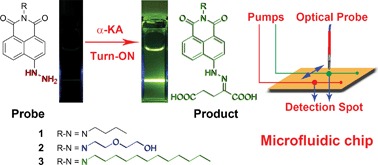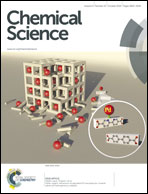Rational design of a turn-on fluorescent sensor for α-ketoglutaric acid in a microfluidic chip†
Abstract
Detection of biomarkers via optical microfluidic chips is in great demand for high contrast biosensing and bioimaging. In distinct contrast with traditional chromatographic methods, which require tedious pretreatment and are not directly applicable in blood serum, a “turn-on” fluorescent sensor for the cancer cell damaging agent α-ketoglutaric acid (α-KA) has been established. A hydrazino group is introduced into the naphthalimide moiety as the reaction trigger for the specific fluorescence turn-on response. Under the rational design, probe 3 can successfully detect α-KA in a purely aqueous system, along with approximately 7-fold fluorescence enhancement and a rapid response with the aid of micelles. The sensor exhibits good selectivity among 20 common amino acids, in particular showing little interference with various dicarbonyl derivatives and reactive oxygen species. Finally, the detection of α-KA in human serum is demonstrated in a microfluidic chip, indicative of a potential platform for high-throughput screening and monitoring of kinetics, especially in biological fields.


 Please wait while we load your content...
Please wait while we load your content...